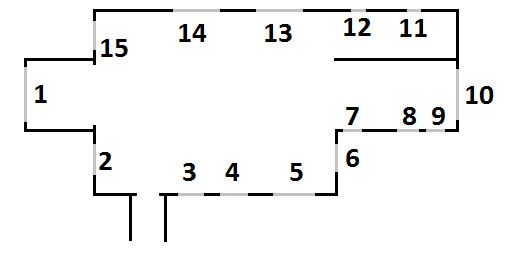
- St John the Evangelist. A.L. Moore
- Two depictions of Jesus, the light of the world and the good shepherd. Ion Pace
- Doubting Thomas. Clayton and Bell
- Peter raises Tabitha. Clayton and Bell
- Faith, Hope and Charity
- The centurion with the sick servant
- The raising of Lazarus. Clayton and Bell
- Jesus in the house of Martha and Mary at Bethany . Clayton and Bell
- Touch me not. Clayton and Bell
- Type and antitype. Ward and Hughes 1866
- Burland coat of arms. A.L. Moore
- Coat of arms. A.L. Moore
- The Angel Gabriel appearing to the shepherds. A.L. Moore
- The young Christ with his parents. A.L. Moore
- Saints Peter and Paul. Ion Pace
In the clerestory, the Zeppelin windows. A.L. Moore
Note : You can click on (most of) the pictures of the complete window to see a larger image.
There are three windows in the church with plain glass, a small two light window in the porch, a square-headed low side window below window 7 and the east window of the former vestry.
1 Saint John the Evangelist
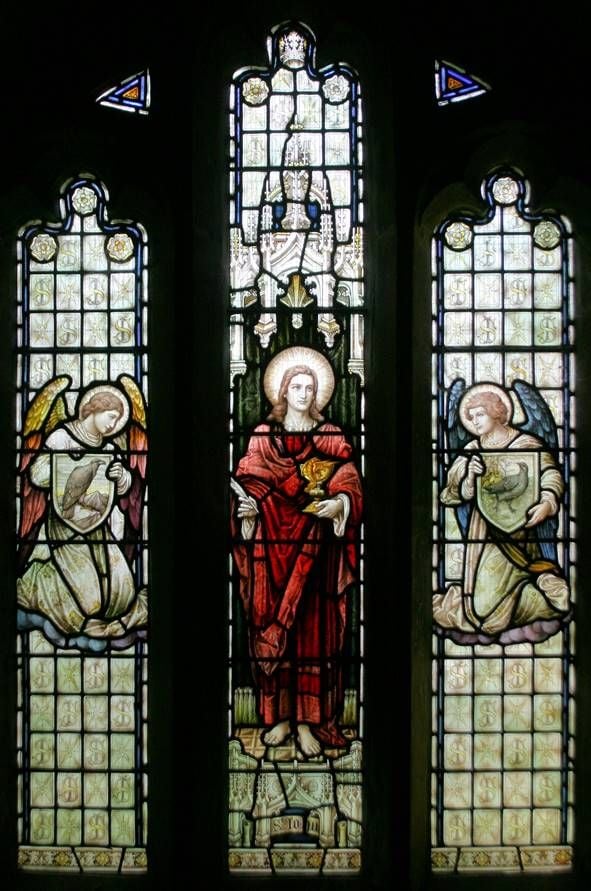
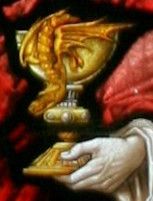 St John holds a quill depicting his status as a Gospel writer. As here, he is usually shown with a chalice containing a dragon or a snake. There is an old legend that once St. John was given a cup of wine which had been poisoned but that, by his blessing of the drink, the poison came out of it in the form of a snake or dragon and John drank from the cup unharmed.
St John holds a quill depicting his status as a Gospel writer. As here, he is usually shown with a chalice containing a dragon or a snake. There is an old legend that once St. John was given a cup of wine which had been poisoned but that, by his blessing of the drink, the poison came out of it in the form of a snake or dragon and John drank from the cup unharmed.
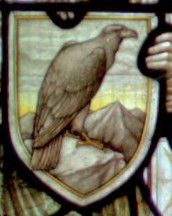 He is almost always accompanied by an eagle, shown on the shield held by the angel on his right. The eagle was a symbol of the resurrection and noted for its ability to soar to great height.
He is almost always accompanied by an eagle, shown on the shield held by the angel on his right. The eagle was a symbol of the resurrection and noted for its ability to soar to great height.
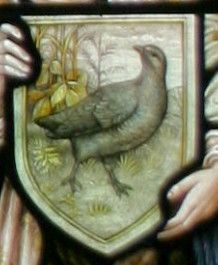 The other angel holds a shield showing a partridge. The partridge reference is more obscure but this may explain it. Cassiodorus saith that a man had given to Saint John a partridge living, and he held it in his hand stroking and playing with it otherwhile for his recreation. And on a time a young man passed by with his fellowship and saw him play with his bird, which said to his fellows, laughing: See how the yonder old man playeth with a bird like a child. Which Saint John knew anon, by the Holy Ghost, what he had said, and called the young man to him and demanded him what he held in his hand, and he said a bow. What dost thou withal? said Saint John. And the young man said: We shoot birds and beasts therewith, to whom the apostle demanded how and in what manner. Then the young man bent his bow and held it in his hand bent, and when the apostle said no more to him he unbent his bow again. Then said the apostle to him: Why hast thou unbent thy bow? And he said: Because if it should be long bent it should be the weaker for to shoot with it. Then said the apostle, So son, it fareth by mankind and by frailty in contemplation, if it should alway be bent it should be too weak, and therefor otherwhile it is expedient to have recreation. The eagle is the bird that flyeth highest, and most clearly beholdeth the sun, and yet by necessity of nature him behoveth to descend low, right so when mankind withdraweth him a little from contemplation, he after putteth himself higher by a renewed strength, and he burneth then more fervently in heavenly things.
The other angel holds a shield showing a partridge. The partridge reference is more obscure but this may explain it. Cassiodorus saith that a man had given to Saint John a partridge living, and he held it in his hand stroking and playing with it otherwhile for his recreation. And on a time a young man passed by with his fellowship and saw him play with his bird, which said to his fellows, laughing: See how the yonder old man playeth with a bird like a child. Which Saint John knew anon, by the Holy Ghost, what he had said, and called the young man to him and demanded him what he held in his hand, and he said a bow. What dost thou withal? said Saint John. And the young man said: We shoot birds and beasts therewith, to whom the apostle demanded how and in what manner. Then the young man bent his bow and held it in his hand bent, and when the apostle said no more to him he unbent his bow again. Then said the apostle to him: Why hast thou unbent thy bow? And he said: Because if it should be long bent it should be the weaker for to shoot with it. Then said the apostle, So son, it fareth by mankind and by frailty in contemplation, if it should alway be bent it should be too weak, and therefor otherwhile it is expedient to have recreation. The eagle is the bird that flyeth highest, and most clearly beholdeth the sun, and yet by necessity of nature him behoveth to descend low, right so when mankind withdraweth him a little from contemplation, he after putteth himself higher by a renewed strength, and he burneth then more fervently in heavenly things.
The window is contemporary with the other A.L. Moore windows in the north aisle. The other Moore windows have a repeating pattern of fleur de lys, stylised flowers or IHS monograms; in this window the background is of repeated SJ monograms.
2 Two depictions of Jesus
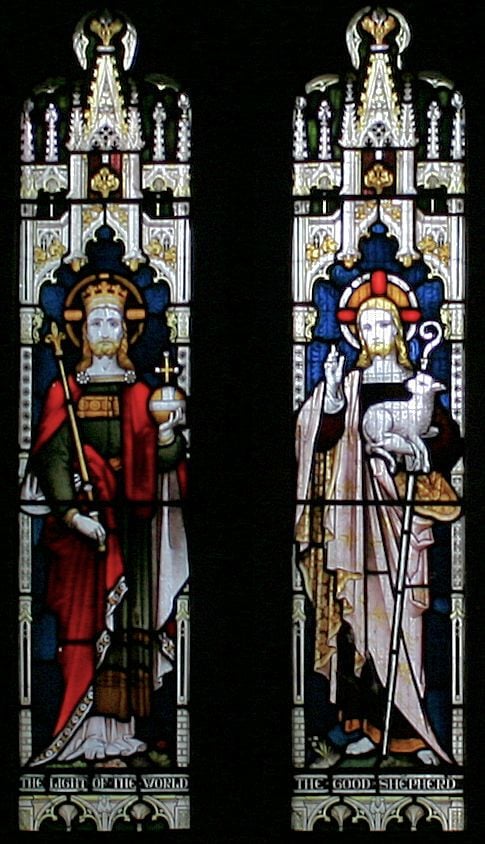
Here are two of the ‘I am’ sayings of Jesus from St John’s gospel. "I am the light of the world" - John 8:12 and "I am the good shepherd" - John 10:11
In the left panel, Jesus is shown as a conventional king, carrying the sceptre and orb of kingship. The sceptre is a pre-Christian sign of authority although with the advent of Christianity, the sceptre was usually topped with a cross or a dove. In this window, the sceptre is topped with a fleur de lys, as with the French Royal sceptre. The orb, of course, represents the Christian world. Additionally, Jesus wears a crown and is richly dressed.
In the right panel, Jesus as the good shepherd is more simply dressed and bare headed. He has with him a shepherd’s crook. He holds a lamb and with his right hand he blesses. The marks of the nails from the cross are visible on his hands. The two windows show authority and humility.
At the base of the window is this inscription-
IN LOVING MEMORY OF WILLIAM PEARSON WHO DIED NOV 10TH 1881 AGED 57 YEARS
William Pearson was born and baptised in Washingborough in 1824. He married Matilda Toung of Lincoln on January 10th 1849 and with whom he had a son, also William. Most of his life he was an agricultural labourer but on the 1881 census he was described as a carrier.
Window number 15 is dedicated to Matilda, his wife. Both windows are the work of the same firm and the name Ion Pace appears on window 15.
3 Doubting Thomas
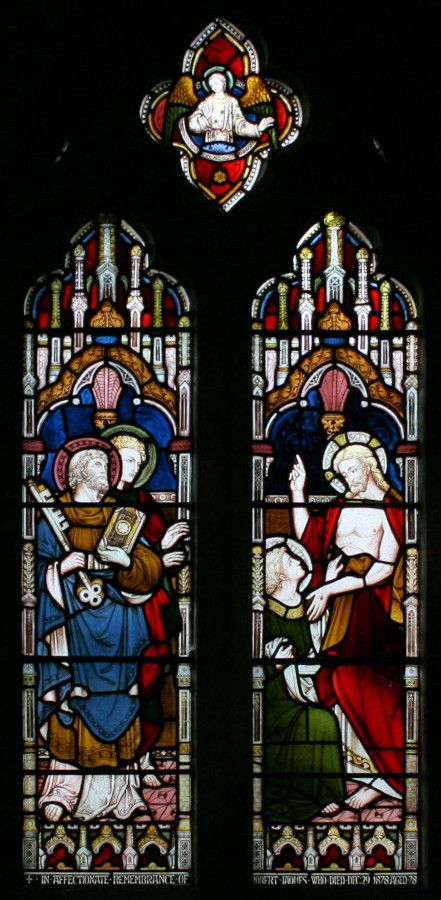
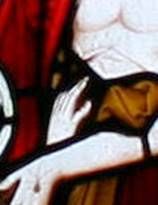 Clayton and Bell produced a huge number of stained glass windows and the quality of the work varied somewhat. In this window St Peter and another apostle stand by whilst Jesus displays his wounds and blesses the kneeling Thomas who still seems to want to touch the wound in Jesus’ side.
Clayton and Bell produced a huge number of stained glass windows and the quality of the work varied somewhat. In this window St Peter and another apostle stand by whilst Jesus displays his wounds and blesses the kneeling Thomas who still seems to want to touch the wound in Jesus’ side.
St Peter’s left hand is strangely shaped and he seems to be not paying any attention to matters.
 Jesus’ right hand also oddly executed.
Jesus’ right hand also oddly executed.
In the quatrefoil above the main windows is a generic angel with gold and green wings.
The inscription at the base of the window reads-
IN AFFECTIONATE REMEMBRANCE OF ROBERT JAQUES WHO DIED DEC 29 1878 AGED 78
Robert Jaques is shown on the 1871 census as a farmer of 50 acres living at Park Villa, Heighington, with his daughter Mary Jaques (who presumably paid for the window) and a housekeeper and a servant. He was buried 4th January 1879 at Washingborough.
The story of doubting Thomas appears only in the Gospel of St John 20:27 -
‘Then he said to Thomas, "Put your finger here; see my hands. Reach out your hand and put it into my side. Stop doubting and believe."’ St Thomas is the dedication of Heighington church.
Window by Clayton and Bell.
4 Peter raises Tabitha
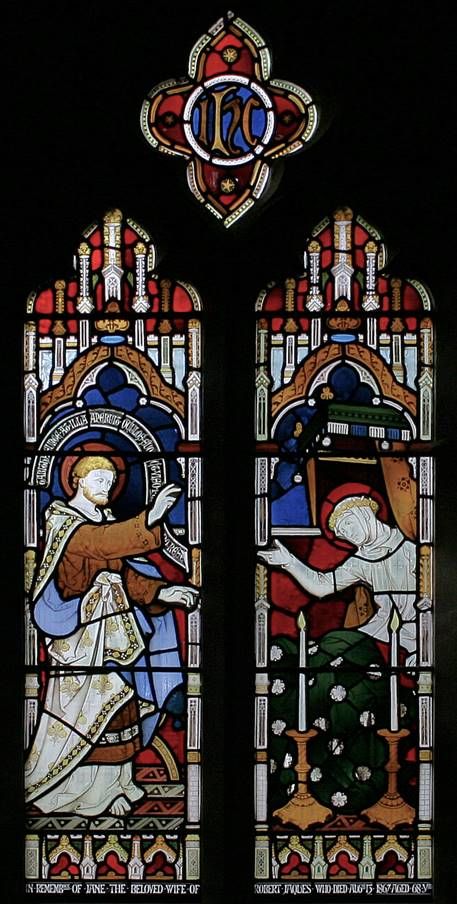
The scroll above Peter’s head reads "TABITA SURGE. AT ILLA APERUIT OCULOS SUOS ET VISO PETRO RESEDIT". This is the Latin translation of Acts 9:40 "...Tabitha, get up! She opened her eyes and seeing Peter she sat up"
Another Clayton and Bell work. Apart from the subjects themselves, all the decorative work is identical with window 3. Peter, for once without his keys, restores Tabitha to life. Tabitha was also named in Greek as Dorcas and lived in Joppa, a large port in Israel now known as Jaffa.
Above in a quatrefoil is an ihc Christogram.
The subject is appropriate as the window is dedicated to a woman. The inscription reads-
IN REMEMBNCE OF JANE THE BELOVED WIFE OF ROBERT JAQUES WHO DIED AUGST 13 1867
AGED 68YRS
In the 1861 census Jane is shown living with her husband Robert in Heighington. At that time he was an agent to a distiller.
5 Faith Hope and Charity
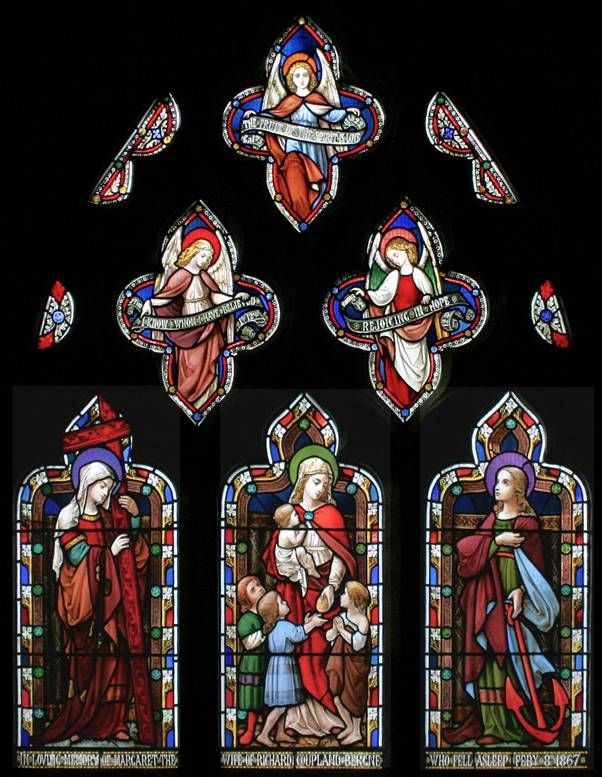
The three female Saints are actually depicted left to right as Faith, Charity and Hope. Saint Faith clings to a red coloured cross, Saint Charity feeds young children and Saint Hope is shown with a large red anchor whilst she draws her mantle across herself, perhaps against the ‘storm of life’.
The three women have footwear; most men in stained glass are shown barefoot. Saint Hope is bareheaded. Because the individual windows are wide and low there is no need for an elaborate canopy over the figures’ heads.
Above the three are three angels carrying scrolls, each with an appropriate verse from the epistles.
Above St Faith is 2Timothy 1:12 I KNOW WHOM I HAVE BELIEVED
Above St Charity is Galatians 5:22 THE FRUIT OF THE SPIRIT IS LOVE
Above St Hope is Romans 12:12 REJOICING IN HOPE
At the base of the window is the dedication-
IN LOVING MEMORY OF MARGARET THE WIFE OF RICHARD COUPLAND BERGNE WHO FELL ASLEEP FEBY 3RD 1867
There is little about Margaret to be found. She lived between 1839 and 1867. Her husband was known as Richard Bergne, age 24, living with his uncle Richard Coupland at Skellingthorpe Hall on the 1861 census. He was a landowner and in 1876 was lord of the manor of Washingborough. He also owned property in Waddington. He was a Justice of the peace in 1872 and living at Skellingthorpe hall again. He died in 1895.
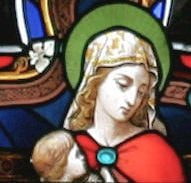
This is the only pictorial window in church representing non-scriptural figures. Whilst the three virtues are in the epistles, the figures as saints (and their mother Saint Wisdom) seem to be an early legend.
6 The centurion with the sick servant
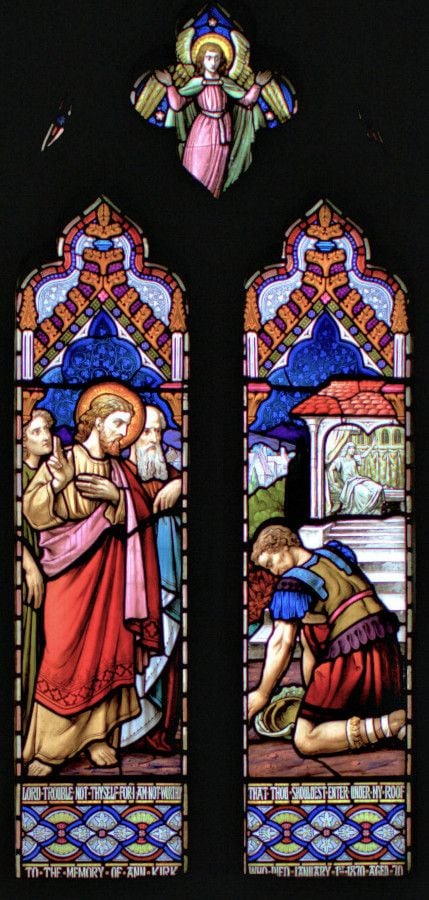
The work in this window is of high quality. The leading for the glass is almost invisible and a simple palate of about 8 colours used to good effect. The figures are very natural but the town in the background looks very European.
The story of the centurion’s servant is in Matthew and Luke. In Matthew, the centurion comes to see Jesus himself. In Luke, where the quote on the window comes from, the centurion sends various Jewish elders and friends with messages to Jesus. The window is a combination of the two stories but the point common to them both is the strength of faith of the Gentile centurion. The window has this inscription-
LORD TROUBLE NOT THYSELF FOR I AM NOT WORTHY THAT THOU SHOULDEST ENTER UNDER MY ROOF
TO THE MEMORY OF ANN KIRK WHO DIED JANUARY 1ST 1870 AGED 70
In the Parish register her burial is recorded with the words ‘For nearly 40 years a faithful and valued servant in the family of J Dudding late of Lincoln.’ Her funeral was conducted by J Dudding, Rector and F Day, curate. She is buried in a grave to the south of the chancel, next to Dudding.
7 The raising of Lazarus
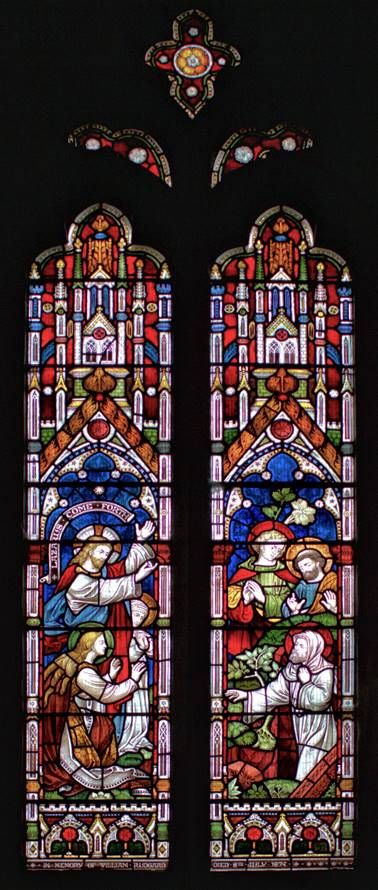
Another biblical story only found in the gospel of St John. In the left light stands Jesus with Martha and Mary, Lazarus’ sisters. In the right are two disciples and Lazarus, emerging from the tomb, which seems to have a carved wooden door rather than a large stone.
AT the base of the window is this inscription-
IN MEMORY OF WILLIAM RUDGARD DIED 8TH JULY 1875
William was born in 1801 and spent most of his life in Newland House, a large house set in grounds now occupied by Lincolnshire County Council offices. The façade of the house is incorporated in the north range of the offices. He married Ann Kirk (not the Ann Kirk of window 6) of Lincoln in 1834. They had seven children but by 1851 he was widowed. He was variously a merchant, a corn merchant, a magistrate and a director of the Midlands Insurance Company. Rudgard Lane, close to the site of his house is named after him. He died in Lincoln in 1875 and was buried at Washingborough.
The window, by Clayton and Bell, may have been commissioned by William, his eldest son.
8 Jesus at the house of Martha and Mary at Bethany
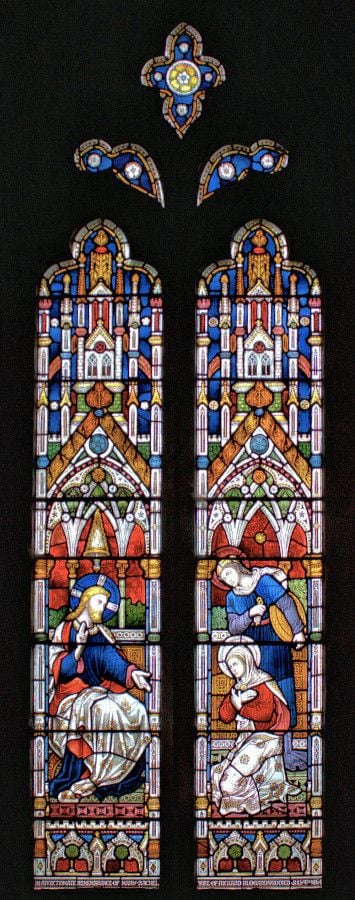
According to the Gospel of Luke:
As Jesus and his disciples were on their way, he came to a village where a woman named Martha opened her home to him. She had a sister called Mary, who sat at the Lord's feet listening to what he said. But Martha was distracted by all the preparations that had to be made. She came to him and asked, "Lord, don't you care that my sister has left me to do the work by myself? Tell her to help me!" "Martha, Martha," the Lord answered, "you are worried and upset about many things, but only one thing is needed. Mary has chosen what is better, and it will not be taken away from her.
This is sadly appropriate given the dedication of the window.
The inscription is -
IN AFFECTIONATE REMEMBRANCE OF MARY RACHEL WIFE OF RICHARD RUDGARD WHO DIED JULY 3RD 1864
This window commemorates a sad story. Richard Rudgard was the son of William Rudgard to whom window 7 is dedicated. He was born in Lincoln in 1840 and on the 17th of February 1864 he married Mary Rachel Evans at St Pancras in London. Only five months later Mary was dead. She was 21.
William returned to London and remarried some three years later.
The window is by Clayton and Bell.
9 Touch me not
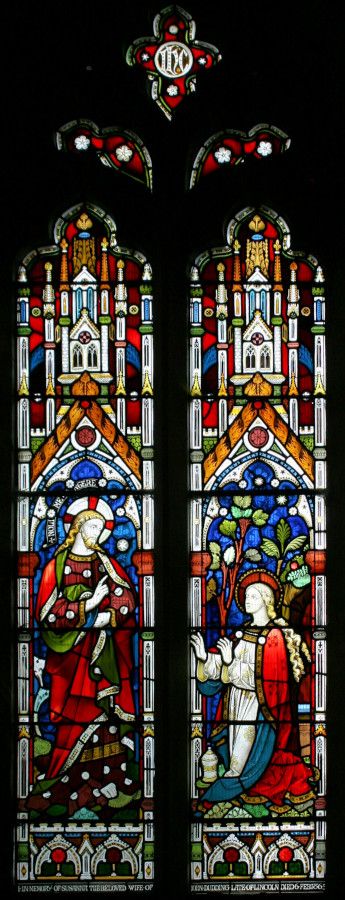
This window shows the beautiful and vivid biblical passage (again from John’s Gospel) of the resurrection. Jesus has just called Mary (Magdalene) by her name and she recognises him and presumably reaches out to touch him. The Latin words in the scroll ‘NOLI ME TANGERE’ mean ‘touch me not’.
Mary Magdalene Is often depicted with a jar, as here, containing something with which to anoint the body of Jesus.
The inscription reads IN MEMORY OF SUSANNA WIFE OF JOHN DUDDING LATE OF LINCOLN DIED 6TH FEBRUARY 1865.
The window is by Clayton and Bell.
10 Type and antitype
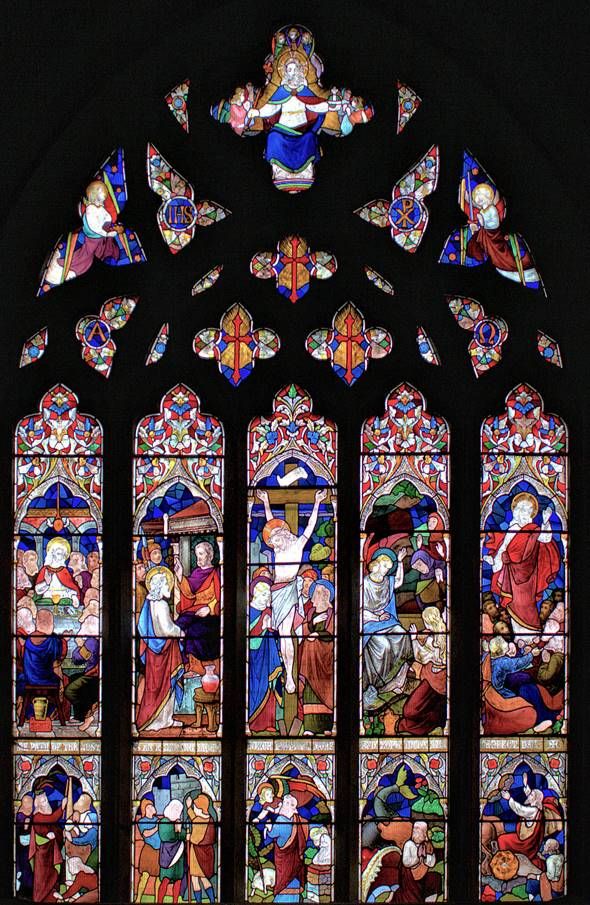
Type and antitype is a doctrine concerning the relationships of the Old Testament to the New Testament. Figures, events or statements from the Old Testament are types which are seen in the New Testament as antitypes, aspects or events of Jesus. For example and as shown in this window, Jonah is seen as the type of Christ’s resurrection in his emerging from the fish’s belly and apparently rising from death.
This window was executed by Ward and Hughes in 1866. The firm began as Ward and Nixon and it was under that name that they got the best glazing contract of the 19th century, the great east window of Lincoln cathedral. Hughes was a pupil of Nixon and took Nixon’s place in 1857. The firm became extremely popular, especially in Lincolnshire, and employed over 100 people but like Clayton and Bell, the quality of the work suffered. Some of the detail of this window has faded. There are two inscriptions, the lower one now hidden by the reredos. This is from the Stamford Mercury 10th August 1866-
"Washingborough Church - the east window ... has recently been filled with painted glass as a memorial to the late Incumbent, the Rev H.W. Sibthorpe. Each of the main lights consists of two subjects richly set, the upper and principal tier being ‘the Last Supper’, ‘Christ before Pilate’, ‘Crucifixion’, ‘Resurrection’ and ‘Ascension’ and below these ‘the Fall of Manna’, ‘Joseph in prison’, Issac offered’, Jonah escaping from the fish’ and ‘Elijah ascending’, thus and forming type and antitype. The principal figure in the tracery above is ... our Lord seated in Glory and in the next largest openings are the archangels- Gabriel on our Lord’s right and Michael on the left. At the base is the following inscription ‘Erected by the parishioners in affectionate remembrance of the Rev. H. W. Sibthorpe, B.D, 48 years rector of this parish’"
The upper inscription reads -
THE PATH OF THE JUST IS AS THE SHINING LIGHT THAT SHINETH MORE AND MORE UNTO THE PERFECT DAY (Proverbs 4:18) This was taken as the text for a sermon preached in St John’s on the Sunday following the funeral at Canwick the day before.
In the upper part of the window are four symbols. The Alpha and Omega (A and O) stand for beginning and end. Above is IHS which is the first three letters of Jesus' name in Greek and the monogram of the letters PX (Chi Rho) which the beginning of the Greek word for Christ and the origin of using Xmas for Christmas. In the very top of the window is Christ in Glory.
Humphrey Waldo Sibthorpe was born in 1791 at Canwick. He married Mary Esther Ellison of Beverley at St Mary’s, Beverley in 1818. They had one daughter. He died at the rectory on Saturday the 4th of November, 1865. He remains the longest serving incumbent of St John’s. Remarkably, he was also the Rector of Hatton, near Wragby.
11 Burland coat of arms
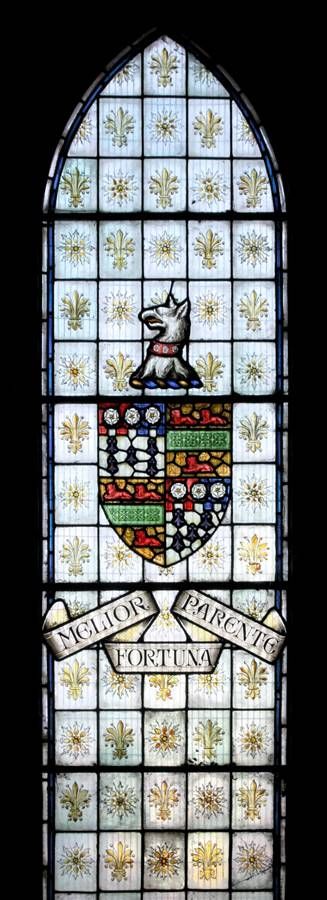
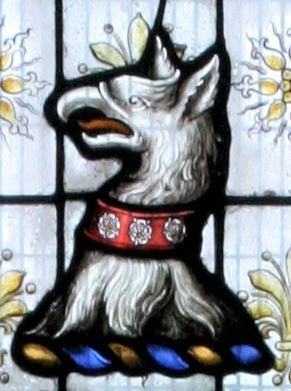
The Coat of Arms of the Rev William Burland. It was he who was responsible for the installation of the ‘Zeppelin’ windows and was modest enough to have his arms displayed in stained glass.
The motto ‘MELLIOR FORTUNA PARENTE’ is a quote from an ode by Horace -
"quo nos cumque feret melior fortuna parente"
Which translates -
"Comrades and followers, we’ll go wherever Fate, kinder than a sire, provides".
12 Coat of arms
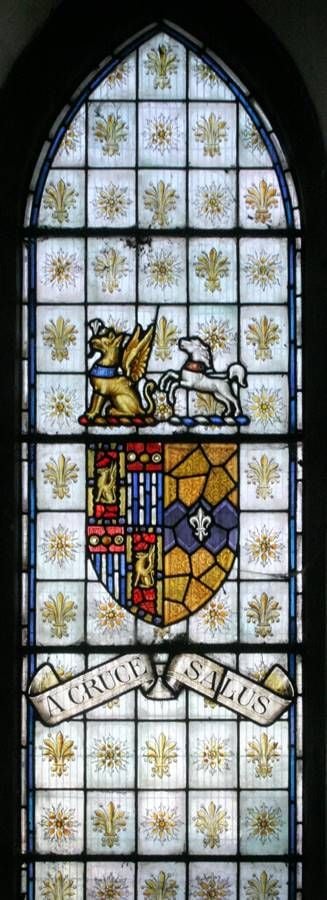
At present, little is known about this window. It is by the same maker as number 11 which was installed by Rev William Burland and is assumed to be contemporary with that window. Both are probably by A.L. Moore who also made numbers 1, 13 and 14.
The arms are of the Rev Joseph Donnington-Jefferson of Thorganby, York. The Motto is Latin for ‘From the cross comes salvation’ and has been used by several armigerous families.
13 The Angel Gabriel appearing to the shepherds
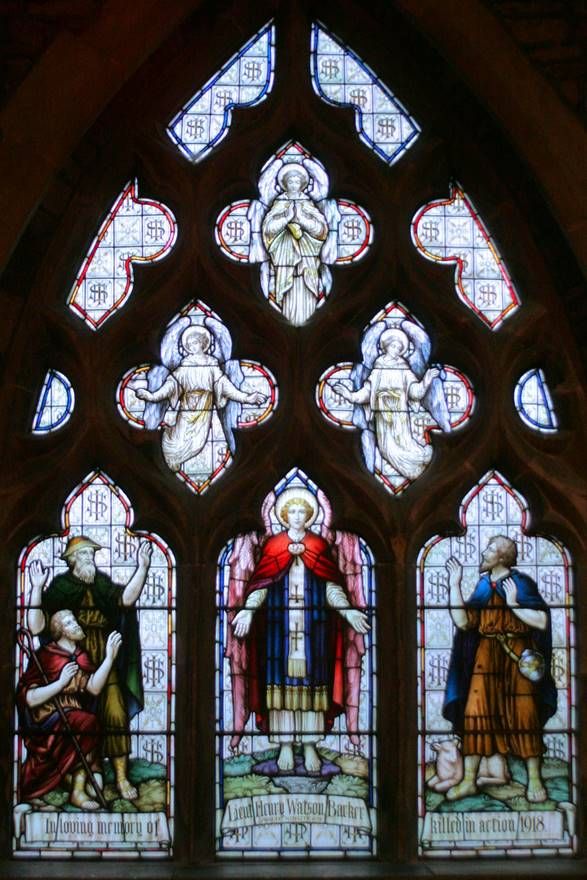
This striking window by A.L. Moore shows Gabriel in the centre with two shepherds on the left and one on the right. The shepherds seem rather well dressed for what was a fairly low level occupation. Certainly the colour range of their garments has had some artistic license. Their poses too, are rather artificial and one shepherd carries what looks like a metal water container. Of course, historical accuracy was not part of the stained glass window designer’s work. The window is beautifully painted although it is an odd choice for a memorial window for a young man killed in war.
The top of the window is identical with window 14.
The inscription reads "In loving memory of Leiut Henry Watson Barker (aged nineteen) killed in action 1918".
Henry was born in Heighington, son of Thomas and Florence Barker in 1898. He joined the Lincolnshire Regiment and was a Lieutenant in the 4th Battalion. He was killed in action in the first Battle of Kemmel Ridge on April 17th 1918. He is buried in Baileul Community Cemetery in northern France, near the Belgium border. It is unclear why Henry merited this window, he was not the youngest or the first Washingborough/Heighington man to die in the War.
14 The young Christ with his parents

This beautifully detailed window is contemporary with number 13 and by the same maker.
It shows Mary the mother of Christ seated; two doves (pink) symbolise motherhood. Joseph seems to be instructing Jesus. Jesus is working at a very modern workbench with tools unlikely to have been used 2000 years ago. Jewish carpenters of that time would have been responsible for the wooden framing for roofs, for doors and door frames and smaller work such as furniture and yokes and shovels. They would have limited access to iron but would have used saws, adzes and hammers as well as bronze or iron nails. The background is of IHS monograms.
Information about Augustus Pattisson is patchy. He was born in 1824 in Southampton and in 1842 was awarded the Master of Law and Master of Arts degrees from Christ’s College, Cambridge. In 1856 he was an Ensign in the Staffordshire Militia and promoted to lieutenant three years later. In 1863 he was promoted to captain and later to major. In 1881 he was promoted to the honorary rank of Lt Colonel. He never married.
In the 1911 census he was described as a visitor at Washingborough Hall but he was clearly a long term guest as he died there on the 18th September 1919. He left the sum of some £48000, more than £1.7 million in today’s terms. Maybe it was his money that paid for twelve windows (including the Zeppelin ones) in the church.
15 Saints Peter and Paul
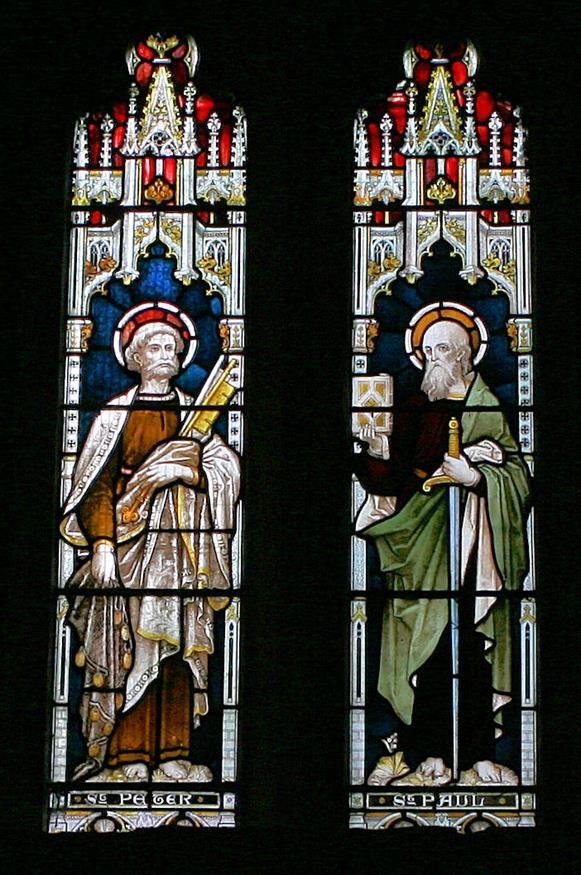
This part of the window can’t be viewed from the church floor. It shows the dedication to Matilda Pearson, wife of William to whom window 2 is dedicated. It also shows the maker’s details -

Ion Pace worked for Clayton and Bell before setting up on his own. His style is very similar to that of his former employers. St Peter holds the keys to heaven as he usually does and St Paul holds his writings and the sword which symbolises his traditional beheading as a martyr.
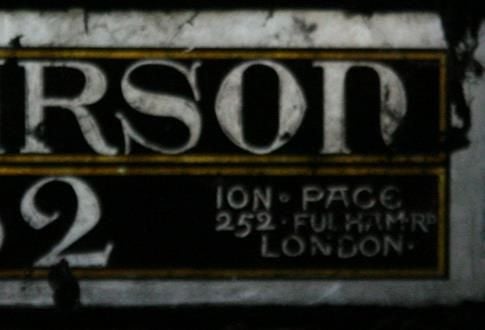
The Zeppelin windows
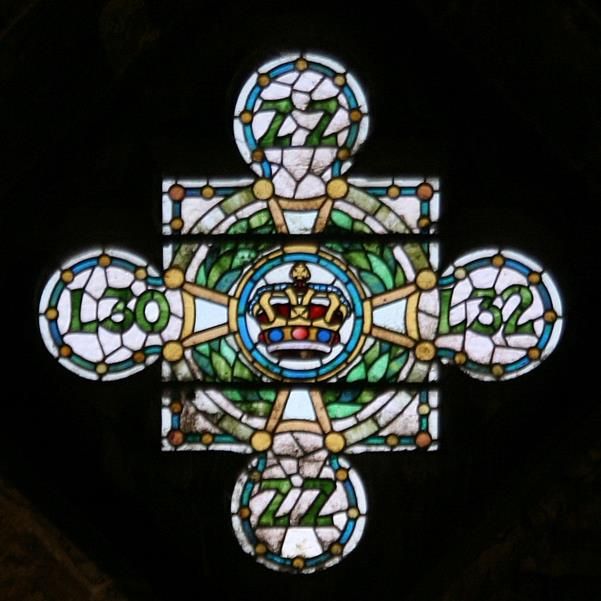
In the Clerestory are eight identical windows installed after WW1 by Rev William Burland. It’s likely they were the work of A.L. Moore as were the other windows installed by Burland. The windows were put in to commemorate the bombing of Washingborough by Zeppelin L14 on the night of 23rd September 1916. The windows have the two Zeppelin numbers L30 and L32, neither of which were responsible for the bombing.
A searchlight at Washingborough caught L14 in its beam and a 12 pounder gun at Canwick fired nineteen times at it causing the crew to drop the entire load of weaponry.
Seventeen incendiary bombs were dropped on Heighington. Of twelve high explosive bombs, one bomb fell in a Washingborough garden and others in fields and a further fifteen between Washingborough and Greetwell. There were no casualties but a chicken shed and an orchard were destroyed and some outbuildings damaged.
The following day, many sightseers from Lincoln came to view the damage. A large number wanted to cross the Witham by means of the chain ferry and sadly on one trip it tipped its passengers into the river and two boys were drowned, caught under the flat bottom of the ferry.
Arthur Ernest Robinson was seventeen and lived on Carlton Street, Lincoln. He is buried in Newport Cemetery. George Melson was just seven. He lived on Winnowsty Lane and is buried in Eastgate Cemetery.
L14 was the most successful German airship of the war, attacking Britain 17 times and dropping more than 22 tons of bombs. It was destroyed by its crew after the war.
L 30 and L32 were airborne that same night but were involved in bombing raids elsewhere. L 30 failed to make land and dropped its bombs over the sea. L32 bombed parts of Kent and was shot down with the loss of the entire crew. It’s not clear why those numbers were represented in the windows. Nor is there an obvious reason for including the letters ZZ. German airships had a ‘tactical’ number such as L31, L32 and a production number which began with the letters LZ, an abbreviation for Luftschiff [airship] Zeppelin. Maybe ‘ZZ’ looked more menacing?
Colin Ward - Churchwarden (2019)